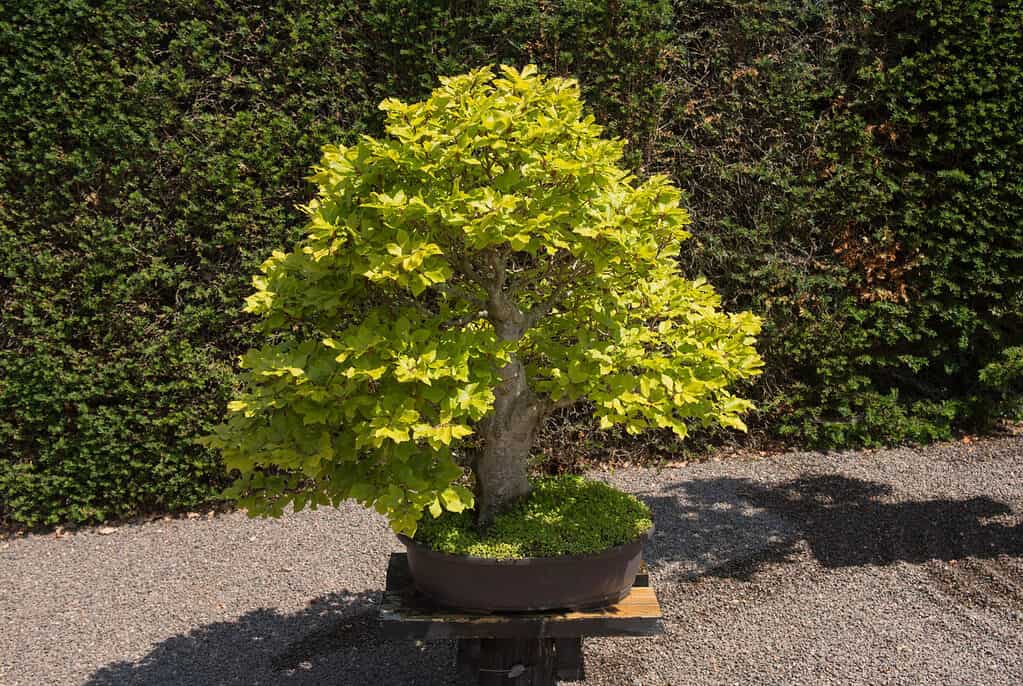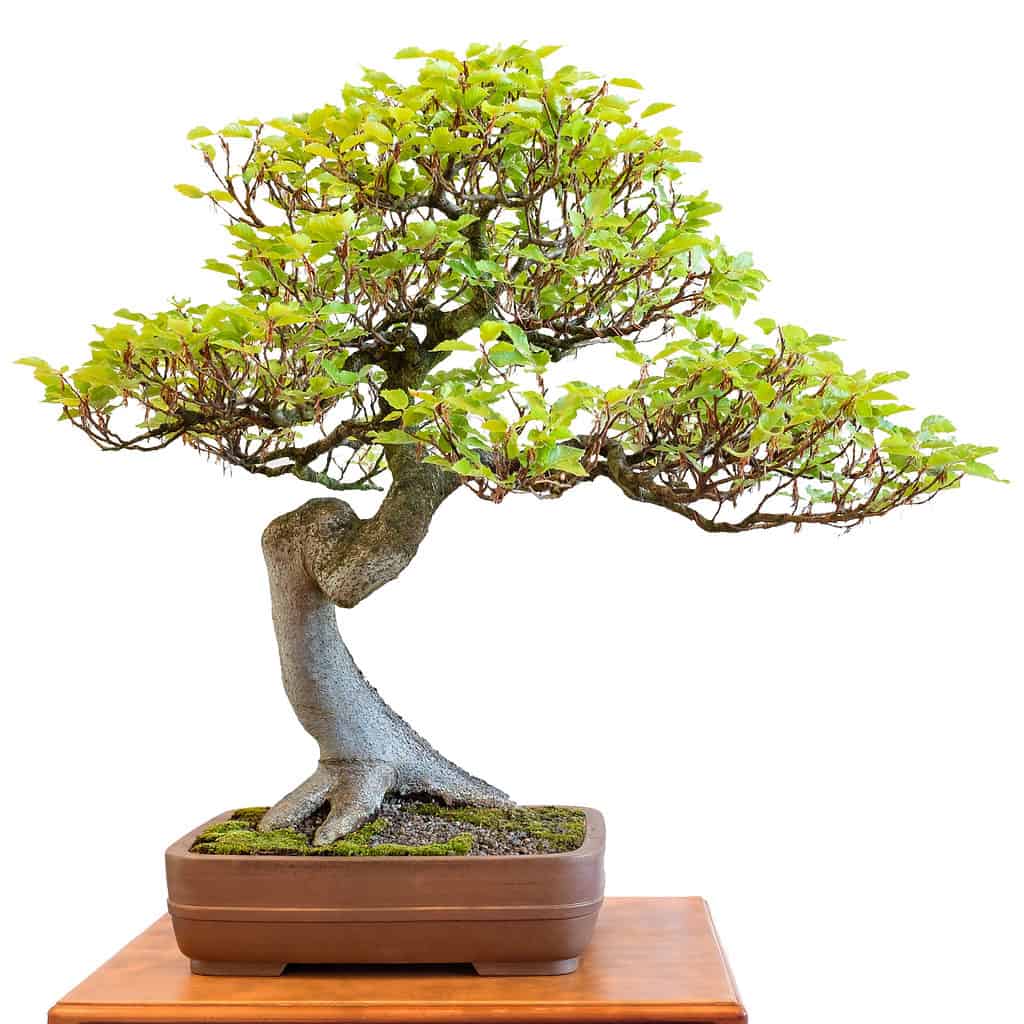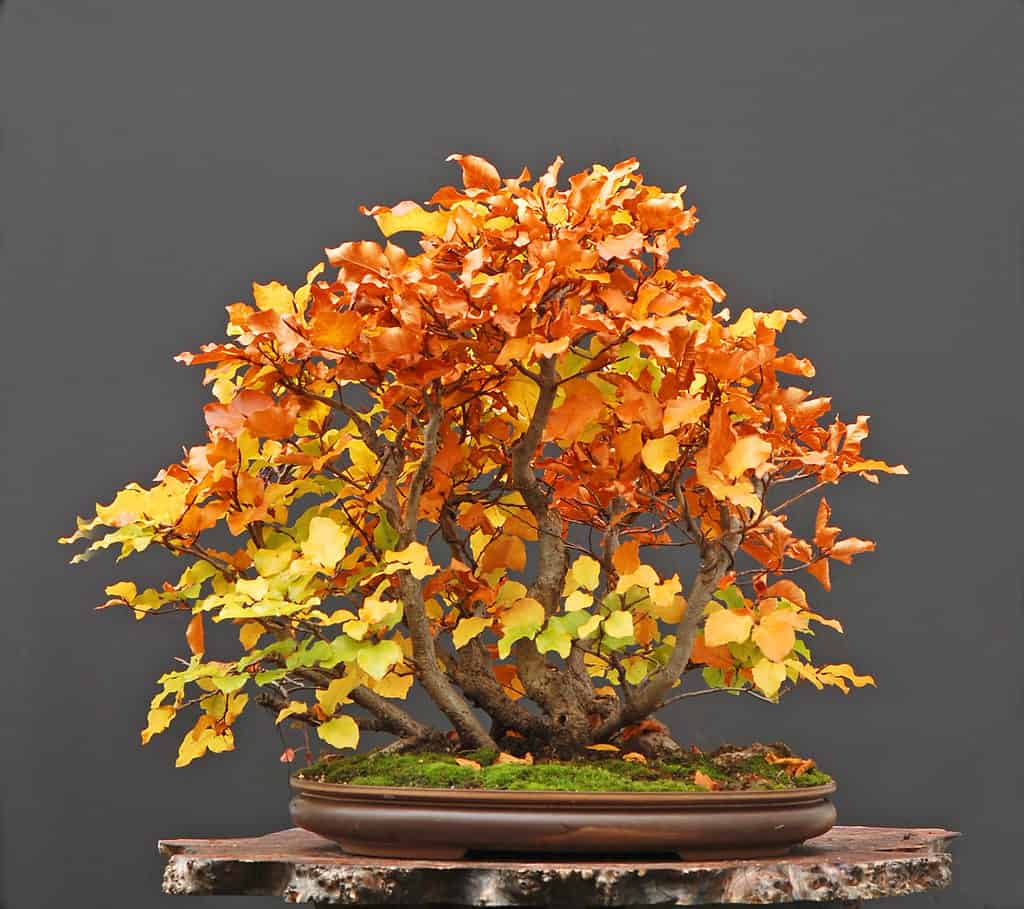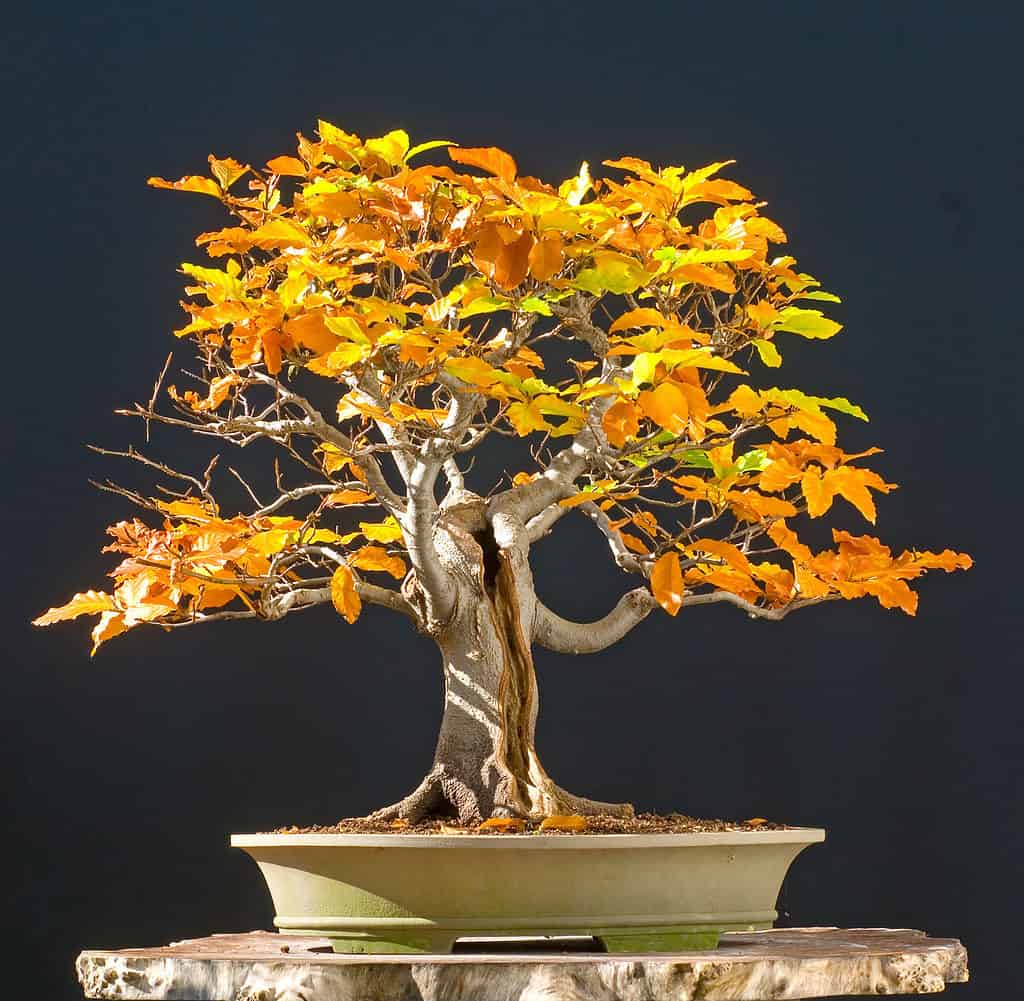Beech trees are not known for being easy to grow as Bonsai trees. But the payoff is more than worth it, as these beautiful trees add color and style to a Bonsai tree garden. What are the different kinds of beech trees that can be grown as Bonsai trees? How do you take care of them to ensure that they grow properly?
Here, we’ll tell you everything that you need to know about growing beech Bonsai trees!

With over 1,000 different species, there are plenty of beech Bonsai trees to choose from.
©Peter Turner Photography/Shutterstock.com
| Beech Bonsai Tree Facts | |
|---|---|
| Botanical Name | Fagus |
| Common Types | American beech, European beech, Copper beech, Tri-color beech, Japanese beech, Chinese beech, Weeping beech, Fern-leaved beech |
| Sunlight | Full sun to partial shade, four to six hours a day |
| Soil | Depends on the type of beech tree, but most beech trees can tolerate all kinds of soils and soil conditions. |
| Water | Moist, well-drained; since beech trees grow at a slow rate, they do not need too much water! |
| For Beginners? | Intermediate to Advanced |
| Indoors or Outdoors? | Outdoors year-round. Need to be protected from frost, which can be damaging |
| Pairs Well With… | Moss and other natural ornamentation. |
Common Types of Beech Bonsai Trees
There are only 10-13 types of beech trees, and all of them can be grown as Bonsai trees with enough patience and care. Here are some of the most common types of beech Bonsai trees.
American Beech
The American beech tree is the only type of beech tree that is native to North America. During the autumn months, the light green leaves on these trees turn a golden bronze color. These trees are slow growing and achieve less than 24” of growth a year when planted naturally. However, they grow very well and are relatively easy to take care of.
American beech trees thrive best in full sun to partial shade. They grow well in just about every kind of soil and soil condition, as long as the soil is well-draining. They are also very tolerant of drought!
European Beech

The popularity of beech Bonsai trees doesn’t necessarily mean they are easy to care for.
©Bernd Schmidt/Shutterstock.com
The European beech tree is the most common type of beech tree throughout the world. These trees are also slow growing and achieve less than 24” of growth a year when planted naturally. However, they grow very well and are relatively easy to take care of.
European beech trees can grow in both full sun and partial shade, though they do best in full sun. They grow well in just about every kind of soil and soil condition, as long as the soil is acidic and well-draining. They are somewhat tolerant of drought, but it is still best to keep to a consistent watering with a European beech.
Copper Beech
The copper beech tree is actually a variety of the European beech. They are also native to Europe. The leaves on this tree are lovely copper and even purple shades throughout the year. During the autumn months, these leaves turn red. Copper beech trees thrive best in full sun to partial shade.
Tri-Color Beech

Your beech Bonsai tree is capable of beautiful fall foliage.
©Walter Pall/Shutterstock.com
The tri-color beech is actually another variety of the European beech. they are also native to Europe. The leaves on this tree come in a variety of lovely, unique colors. Green, white, and pink are the most common. These three colors give the tree its name. The tri-color beech tree can grow in just about any soil and soil conditions, though it prefers acidic soils. It thrives best in partial shade. If it grows beneath full sun for too long, its leaves may end up scorched.
Japanese Beech
The Japanese beech tree is native to Japan. Specifically, it calls the sprawling forests of Japan its home. The Japanese beech tree is probably the most popular of the beech trees when it comes to Bonsai tree art. When planted naturally, these trees can grow very tall. There have been recorded cases of them reaching heights of 200 feet or more.
The Japanese beech tree thrives best in sandy or loamy soils that are well-draining. They can grow under full sun as well as partial shade, as they are very tolerant of shade.
Chinese Beech
The Chinese beech tree is native throughout eastern, southern, and central China. The blue-green leaves of this tree bloom yellowish catkins in May. It thrives best beneath full sun and can grow well in just about every kind of soil and soil condition, as long as the soil is well-draining. The Chinese beech tree can tolerate freezing temperatures.
Weeping Beech
The weeping beech tree is actually another variety of the European beech. They are also native to Europe. These trees thrive best beneath full sun and partial shade. They need moist, acidic, well-draining soil to grow well. Despite how dense these trees can be, especially when planted naturally, they are relatively low maintenance.
Fern-Leaved Beech
The fern-leaved beech tree is actually another variety of the European beech. They are also native to Europe. The fern-leaved beech is known for its fine, serrated leaves. These leaves go from a dark green color in the spring to bronze, reddish colors in the autumn months. These trees thrive best beneath full sun. They need moist, well-draining, loamy soil to grow well. Fern-leaved beech trees are also relatively low maintenance.
Caring for Your Beech Bonsai Tree

A semi-cascade Bonsai style may suit your beech tree well.
©Bernd Schmidt/Shutterstock.com
As a whole, taking care of a beech Bonsai tree isn’t too difficult. Sometimes the care requirements of one type of beech tree can differ when compared to another. For instance, some beech trees enjoy sunny spots, while others do not do well under full sun. Make sure you know what kind of beech tree you are growing so you can help it grow properly!
Here are some guidelines on how to care for a beech Bonsai tree.
Sunlight
For the most part, beech trees enjoy full sun. There are some that prefer partial shade or tolerate it, at the very least. With some varieties, specifically the Tri-Color beech, it is recommended that they be kept from full sun as much as possible. Being exposed to direct sunlight can sometimes cause their leaves to burn.
Soil Type
There are many types of beech trees that can grow well in all kinds of soils and soil conditions. Make sure that whatever soil you use for your Bonsai beech tree is well-draining. Because you are growing a Bonsai tree, this is easier to achieve. Bonsai trees require special soil mixtures, and these mixtures are designed to be well-draining. You can make these mixtures yourself, or buy them pre-made!

Some beech Bonsai tree species are more cold-tolerant than others.
©Eric Isselee/Shutterstock.com
Water
As soon as the soil is dry, a beech Bonsai tree needs to be watered. Since they grow at a slower rate than other trees, they do not need too much water. Take care, however, to keep the soil at least slightly moist whenever possible. There are a few types of beech trees that can withstand or tolerate drought, like the American beech tree and the European beech tree. But it is still a good idea to water them consistently to ensure that they grow well.
Placement
In the winter months, beech Bonsai trees must be kept safe from frost and freezing conditions. Most beech trees are hardy and can tolerate cold temperatures, but the frost can be damaging. When temperatures begin to drop, bring your beech Bonsai tree indoors to protect it.
Pruning Your Beech Bonsai Tree

A forest style for your beech Bonsai tree may look stunning.
©Raquel Pedrosa/Shutterstock.com
In the spring before newer buds begin to bloom and appear, it is a good idea to prune back larger branches from your beech Bonsai tree. When new branches have matured, you can cut them back to two leaves. Technically speaking, you can prune a beech Bonsai tree no matter the season, but be careful pruning during the colder months. If you remove all the buds from a branch during these months, it could die.
Ideal Beech Bonsai Tree Styles
For the most part, there are very few styles in which you can prune and shape your beech Bonsai tree. The most popular style for beech Bonsai trees is Chokkan, otherwise known as the formal upright style. This is ideal for beech Bonsai trees as they have many little branches. Kabudachi is also a popular style for beech Bonsai trees, and it isn’t too difficult to shape the trees in this way.
Propagating Your Beech Bonsai Tree

Beech Bonsai trees change colors with the seasons.
©Walter Pall/Shutterstock.com
There are two ways in which you can try propagating a beech Bonsai tree. The simplest way is from seeds. Beech trees are easily propagated from seeds, which makes it easy on you! However, the second way, which is propagating from cuttings, is not quite as easy. Most beech trees do not take well to this method, unfortunately.
Common Problems with Beech Bonsai Trees
There are a few pests and insects that can harm beech Bonsai trees. To get rid of them, simply use a pesticide. If that doesn’t work, or you don’t want to introduce your beech Bonsai tree to chemicals, try to enhance the environment in which your beech Bonsai tree is growing. For instance, try moving it to a place where it will get more light. You can also try moving it somewhere with better air circulation, or fresher air.
The photo featured at the top of this post is © Bernd Schmidt/Shutterstock.com
Thank you for reading! Have some feedback for us? Contact the AZ Animals editorial team.







